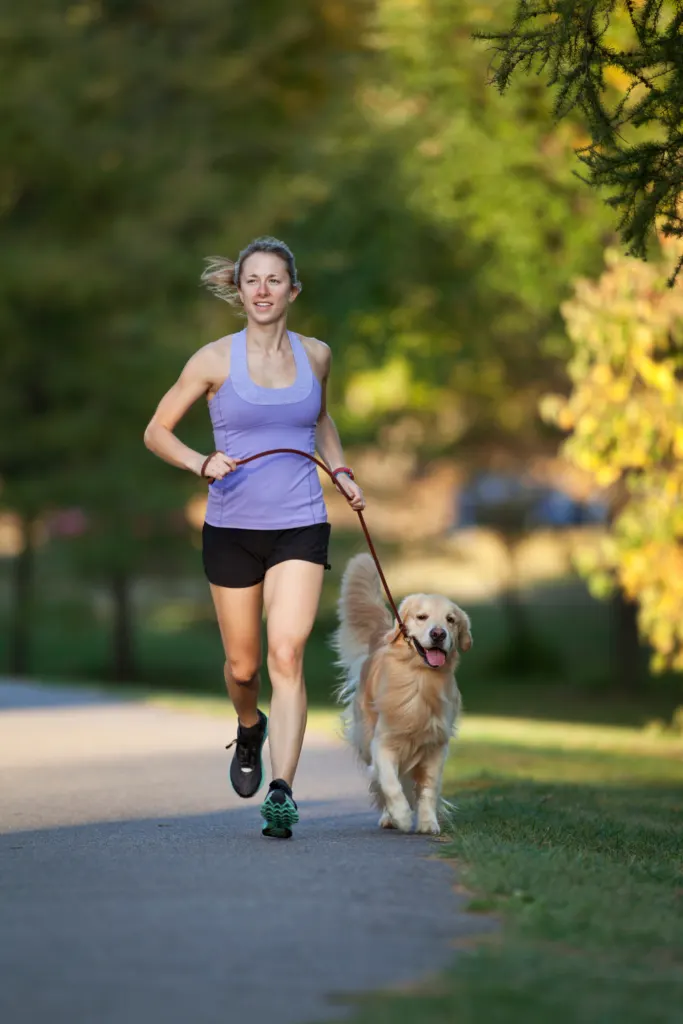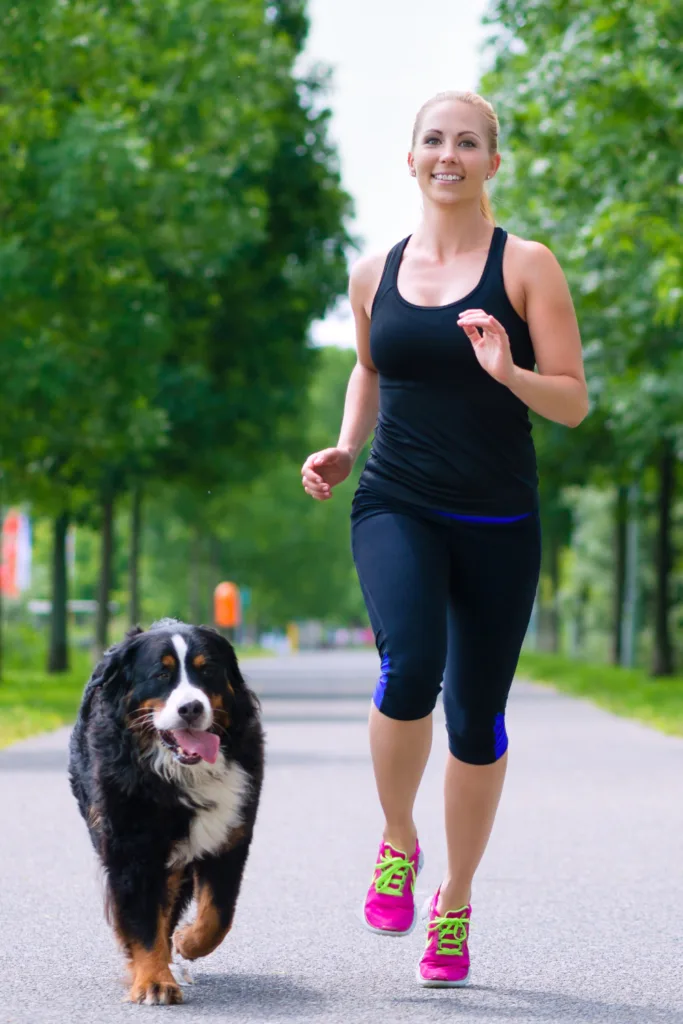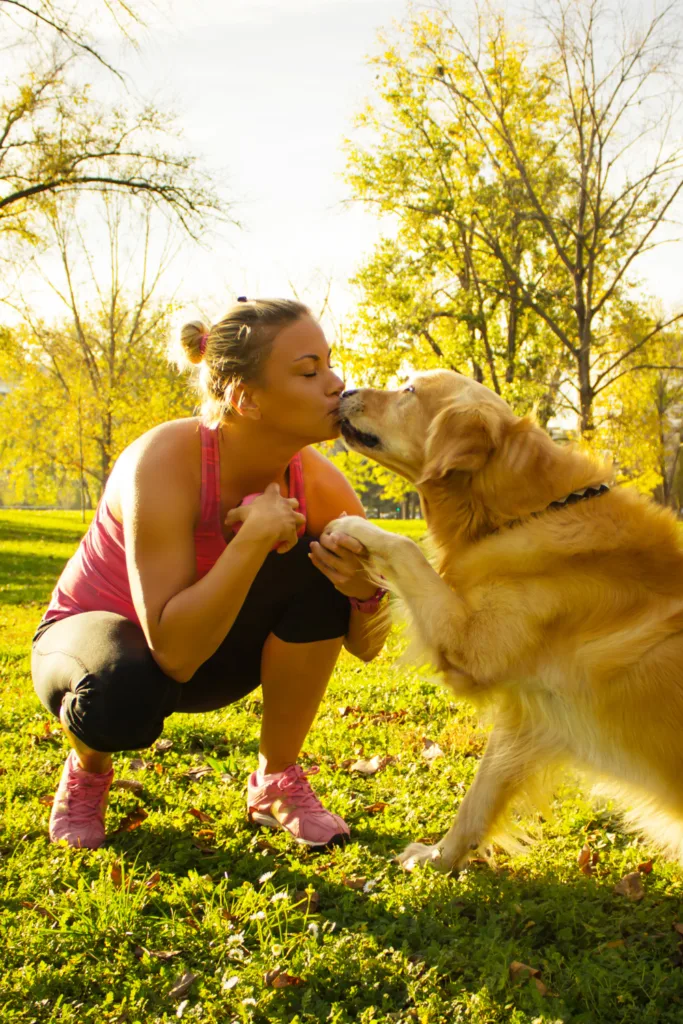Running with a dog has become increasingly popular over the last few years.
Dog ownership has exploded and people are looking for more and more ways to exercise with their pooch.
But before you go for a run or hit the trails, it’s best to check that your dog is actually suited for running.
You’ll also want to check that you have the right running gear.
This includes the right leash and harness for your dog.
In this guide we’ll explore:
- How to start running with a dog: 10 running with a dog tips
- How to train a dog to run with you
- The best and worst dog breeds to go running with
Ready?
Let’s get started!

How to start running with a dog: 10 running with a dog tips
#1 Check that your dog is suited for running
Before planning a run with your dog, you’ll need to check that your dog is actually suited for running.
Not all dog breeds are created equal when it comes to canine fitness.
Some dog breeds are more suited to short sprint distances, whereas others thrive over longer distances.
Some are not suited to running at all.
Dog breeds like Border Collies, Dalmatians and Siberian Huskies are great over long distances.
Breeds like Pugs, English Bull Dogs and French Bull Dogs are not suited to running.
At the end of this guide you will find a list of the best and worst dog breeds to go running with.
#2 Check the age and health of your dog
Your dog’s age and health will give you some indication whether or not you can run with them.
If your dog is still a puppy, for example, it isn’t advisable to run with your dog until their bones are fully formed.
According to the American Kennel Club, running is generally not safe for puppies as their bones are still growing.
Their advice is to wait until the dog is about 1.5 years old before running with them. This applies to most dog breeds.
Likewise, if your dog suffers with health problems such as joint issues because of old age, then it’s wise to skip the run and take them for a leisurely walk instead.
If in doubt, check with your vet first before taking them running.
#3 Train your dog to walk on a leash first
Before you even consider going on a run with your dog, first make sure you have trained them to walk on a leash.
Getting your dog to learn simple ‘walk to heel’ commands will go a long way to help you control and manage your dog when out walking or running.
Another important part of training is to teach your dog to come when called, known as ‘recall’.
This helps to keep your dog safe.
It will also allow you to enjoy the option of ‘off-leash’ walking where it is safe and allowed.
#4 Find a suitable route
If you’re used to running alone without a dog, then it’s wise to do some route planning ahead of time.
You’ll want to check that you can actually run with a dog on your chosen running route.
Many inner city areas have dog-friendly parks and routes, as long as you keep your dog on a leash.
If you’re wanting to run with a dog off-leash, then you may need to find a route in the countryside away from the hustle and bustle of the city.
You will also want to consider the terrain for your dog.
Some dog breeds are well suited for obstacles and rough terrains, whereas others are better suited to flat surfaces and open fields.
#5 Take it slowly
Just like humans, dogs need to build their speed and endurance slowly.
If you and your dog have never been running together, then it’s recommended you start slowly and build up over time.
Start by adding stretches of running during your normal walks then gradually increase the amount of running on subsequent walks.
The idea is that after a number of weeks, your dog will slowly get used to running at a speed comfortable for them.
It’s sensible to run at a speed that is comfortable for your dog.
In other words, if you’re expecting to achieve your next PB on your run, then it’s best to leave your dog at home.
Related: How to use a dog treadmill: The complete guide

#6 Expect regular ‘sniffing’ breaks
Dogs love to sniff and investigate their surrounding area, so expect regular ‘sniffing’ breaks on your run.
A dog’s sense of smell is somewhere between 10,000 to 100,000 times more acute than a human’s sense of smell.
For every scent receptor a human has, a dog has about 50, so imagine all the scents and smells your dog regularly comes across on a walk or run.
According to the Applied Animal Behaviour Science Journal, nose work increases a dog’s optimism.
It also allows them to express a natural behaviour and be more autonomous, which all contribute positively to the dog’s welfare.
So the next time you’re on a run with your dog, give it some time to freely sniff its surroundings.
#7 Get the right dog leash
Dog leashes come in a range of different styles, lengths and materials.
It’s important to think about how you plan to run with your dog and what your dog prefers and finds comfortable.
Comfort, durability and stability are key when it comes to running with your dog using a leash.
Here are the main types of dog leash:
- Standard leash – the most common leash type used for everyday walking and basic training.
- Retractable leash – allows you to vary the length of the leash, better for freedom of movement.
- Adjustable leash – provides a balance between a standard and retractable dog leash.
- Chain leash – a variation of the standard leash, useful for dogs that chew or destroy their leashes.
- Harness leash – provides more comfort for the dog and more control for owners.
- Bungee leash – good for elasticity and helps to absorb shocks when running with a dog.
When it comes to running with your dog, you’ll want to find a combination that suits you and your canine companion.
According to Trail & Kale, whether you run with a specific dog harness or with a leash attached to your dog’s collar comes down to personal preference and your particular dog.
For example, some dogs have a tendency to pull when they are attached to their handler via a harness rather than a collar.
In these situations it may be better for you to use a dog leash for running that is attached to your dog’s collar, which will hopefully discourage them from pulling too intensively.
Here are the harness and leash combinations recommended for each type of run:
- For busier trails and road running in built-up areas, you may prefer a leash without elasticity as you’ll have more control over your dog when running near traffic, pedestrians and other runners.
- For less busy trails over uneven terrains and obstacles, a dog harness with a bungee leash is best as this type of leash combination better absorbs shocks and allows you to twist and turn more easily.
- If you are more confident when it comes to controlling your dog, and your dog doesn’t pull excessively, a hands-free leash attached to a harness may be a good option for you, especially if you plan to run on flat, even surfaces.
#8 Take it easy
While you may pride yourself on being able to run through all types of weather – from rain and snow to dry, hot heat, your dog will simply not want to run in this weather.
Dogs cannot handle heat and humidity as well as humans, so be mindful of the weather conditions when you plan your run.
When running in normal weather conditions, let your dog take “sniffing” breaks.
You may also want to include walking intervals on your run so you don’t push your dog too hard.
After all, running with your dog should be enjoyable for you and your dog.
If at any point your dog’s body language tells you otherwise (e.g. excessive panting, lagging behind), take it as a sign that you need to slow down or stop all together.
#9 Reward your dog
Reward-based training is one of the best forms of training for your dog.
It helps you to form a positive bond with your dog.
This type of training encourages good, ‘wanted’ behaviour by rewarding a dog when they get something right, and often starts when your dog is a puppy.
A reward can be anything from a tasty treat to verbal praise, depending on what your dog enjoys most.
So next time you’re on a walk or run with your dog, reward positive behaviour and ignore unwanted, ‘poor’ behaviour.
Over time, this positive reinforcement will help your dog know how to behave correctly.
#10 Be a considerate dog owner
There’s nothing worse than stepping in a pile of dog poop on your run.
Set a good example by always cleaning up after your dog.
Bring several doggie bags with you each time you take your dog with you on a run.
By doing this you’ll be prepared if your dog needs to poop during your run.
Bio-degradable doggie bags are an environmentally friendly choice compared with regular plastic bags.
Related: How fast can a cheetah run? 22 fastest animals ranked

How to train a dog to run with you
When it comes to running with a dog, there are three training techniques that you can try.
These techniques, when performed correctly, will get your dog to go from walking to running longer distances.
They are:
- Loose-leash walking
- Speed cues
- Progressive intervals
#1 Loose-leash walking
According to the American Kennel Club, you should master loose-leash walking before you start to train them to run beside you.
This is because a dog that pulls on a leash is considered dangerous for both you and the dog when running at speed.
It’s best to get them used to walking without pulling first.
Start by walking your dog either on your left or right side.
Ensure the leash is hanging in a J shape to get your dog into the habit of staying near you.
Start training at a walking pace and keep rewards in mind.
Use treats and praise if your dog keeps the leash slack – this is the type of good behaviour that you want to reinforce.
And always give your dog treats in the position you want to reinforce.
For example, if you want them on your left side, only offer treats at your left leg.
The AKC adds: ‘Keeping your dog on one side of you will be essential when you start running together.
If they run in front of you or weave from side to side, they can trip or tangle your legs in the leash.’
Once you’ve mastered loose-leash walking, you can consider running with a hands-free dog leash.
#2 Speed cues
Once your dog is walking by your side, you can use speed cues.
Speed cues tell your dog when it’s time to pick up the pace or simply continue walking.
Use cues like “let’s go” or “move it” to tell your dog when to speed up and cues like “whoa” to slow your dog down.
When teaching speed cues when running with a dog, it’s best to mix short bursts of running with your normal walking pace.
Give the cue just before you increase or decrease your speed, then reward your dog when they hurry to catch up or slow down.
#3 Progressive intervals
Once your dog has mastered walking by your side and knows when to speed up and slow down, it’s time to work on their endurance using progressive intervals.
An interval is a period of running intermixed with walking.
The idea is that when out walking, you add a small stretch of running, then on each subsequent walk, you make these stretches longer to help build your dog’s endurance.
The key is to gradually increase the time spent running and decrease the time spent walking.
Following several weeks of this type of training, your dog should hopefully be more comfortable running over longer distances.
Related: 12 trail running tips for beginners

The best and worst dog breeds to go running with
Not all dog breeds are created equal when it comes to canine fitness.
Here’s a breakdown of the best and worst dog breeds to go running with.
Dog breeds not suited for running
Dog breeds that have short noses (brachycephalic dog breeds) – think Pugs and Bulldogs – are not well suited for running.
According to the American College of Veterinary Surgeons, brachycephalic means ‘short headed’.
These dog breeds have been bred to have short muzzles and noses.
Because of this, the throats and breathing passages in these dogs are frequently undersized or flattened.
This in turn makes it harder for the dog to breathe properly, resulting in breathing difficulties.
Common examples of brachycephalic dog breeds include:
- English Bulldog
- French Bulldog
- Pug
- Pekingese
- Boston Terrier
- Shih Tzu
- Lhasa Apso
- Griffon Bruxellois
- Affinpinscher
- Cavalier King Charles Spaniel
Dogs breeds suited for short sprint distances
Dog breeds like Greyhounds, Salukis, Afghan Hounds, Whippets and Italian Greyhounds are fast sprinters, but perform better over shorter distances.
So if you’re wanting to run long distances, it’s best to keep these dog breeds at home.
Greyhounds are widely accepted to be the fastest dog breed and are able to reach speeds of up to 45 miles per hour.
Dog breeds like the Greyhound and Afghan Hound also have a strong prey instinct.
This means they tend to chase down small animals which can lead to injury or killing them in some instances.
So it’s worth considering this before you decide to go on a run with this dog breed type.
Dog breeds suited for running long distances
Border Collies, Dalmatians, Siberian Huskies, German Shepherds, Rhodesian Ridgebacks, Jack Russells and Golden Retrievers make fantastic running companions.
These dog breeds excel at speed and endurance and can keep pace on a run due to how they have been bred.
Many of these breeds were originally bred to do certain tasks and activities.
From hunting lions in Africa (Rhodesian Ridgebacks) and herding sheep (Border Collies) to running ahead of firefighting carriages (Dalmatians) to pulling sleds (Siberian Huskies).
Even the small but mighty Jack Russell can run over long distances.
Here are some of the best dog breeds for long distance runs:
- Border Collie
- Dalmatian
- Siberian Husky
- German Shepherd
- Rhodesian Ridgeback
- Weimaraner
- Jack Russell Terrier
- Golden Retriever
- Poodle
- Labrador Retriever
- English Setter
- Airedale Terrier
Related: 7 of the best running workouts to build endurance, strength and speed
- 5 things I wish I’d known before returning to running - March 3, 2024
- Running 20 minutes a day: Benefits + how to start - January 27, 2024
- How to run your first 2 hour half marathon - January 16, 2024
